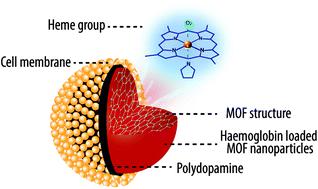当前位置:
X-MOL 学术
›
Biomater. Sci.
›
论文详情
Our official English website, www.x-mol.net, welcomes your feedback! (Note: you will need to create a separate account there.)
Haemoglobin-loaded metal organic framework-based nanoparticles camouflaged with a red blood cell membrane as potential oxygen delivery systems.
Biomaterials Science ( IF 6.6 ) Pub Date : 2020-08-21 , DOI: 10.1039/d0bm01118e Xiaoli Liu 1 , Michelle M T Jansman , Leticia Hosta-Rigau
Biomaterials Science ( IF 6.6 ) Pub Date : 2020-08-21 , DOI: 10.1039/d0bm01118e Xiaoli Liu 1 , Michelle M T Jansman , Leticia Hosta-Rigau
Affiliation

|
Transfusion of donor red blood cells (RBCs) is a crucial methodology required for the treatment of acute trauma and anaemia or for surgical procedures. Due to the many limitations of donor blood, numerous strategies have been explored to develop haemoglobin (Hb)-based oxygen carriers to be used as oxygen delivery systems. However, since free Hb suffers from a lack of stability and short circulation times in blood, an encapsulation platform is needed. Herein, we entrap Hb within a type of metal organic framework (MOF)-based nanoparticle (MOF-NP). By doing so, Hb is protected from misfolding and denaturation, which is a crucial aspect to preserve its excellent oxygen binding and releasing properties. Furthermore, the porous structure of MOF-NPs allows for the diffusion of small molecules (i.e., oxygen) in and out of the system. Our results show that the Hb-loaded MOF-NPs (MOFHb-NPs) are monodisperse and show a small hydrodynamic diameter of ∼220 nm. Importantly, the structure and functionality of the encapsulated Hb are well preserved. To achieve long circulation in the bloodstream, we functionalized MOFHb-NPs with naturally derived RBC membranes and compared the stealth properties of the membrane-coated MOFHb-NPs with our previously reported PEGylation strategy. Protein adsorption and cell uptake studies demonstrate that both coatings are able to significantly decrease the adsorption of proteins and also diminish their uptake by macrophages and endothelial cells. Furthermore, both types of coatings endow MOFHb-NPs with good biocompatibility and oxygen binding and releasing properties. Overall, this study presents a novel oxygen carrier system which might find applications as a blood surrogate.
中文翻译:

血红蛋白负载的基于金属有机骨架的纳米粒子被潜在的氧气输送系统伪装成红细胞膜。
供血红细胞(RBC)的输注是治疗急性创伤和贫血或外科手术所需的重要方法。由于供体血液的诸多局限性,已探索出许多策略来开发基于血红蛋白(Hb)的氧气载体以用作氧气输送系统。然而,由于游离的Hb缺乏稳定性且血液中的循环时间短,因此需要包囊平台。在此,我们将Hb截留在一种基于金属有机骨架(MOF)的纳米颗粒(MOF-NP)中。这样,可以保护Hb避免错误折叠和变性,这是保持其出色的氧结合和释放性能的关键方面。此外,MOF-NP的多孔结构允许小分子扩散(即,氧气)进出系统。我们的结果表明,负载Hb的MOF-NP(MOF Hb -NPs)是单分散的,并且显示出约220 nm的较小流体动力学直径。重要的是,被包封的血红蛋白的结构和功能必须保持良好。为了实现在血液中长循环,我们功能MOF血红蛋白-nps与自然衍生的RBC膜和比较膜的涂敷MOF的隐身性能血红蛋白-nps与我们之前报道的聚乙二醇化战略。蛋白质吸附和细胞摄取研究表明,两种涂层均能够显着降低蛋白质的吸附,并减少巨噬细胞和内皮细胞对蛋白质的摄取。此外,两种类型的涂料均赋予MOF Hb-具有良好生物相容性和氧结合和释放特性的NP。总的来说,这项研究提出了一种新颖的氧气载体系统,该系统可能会作为血液替代品获得应用。
更新日期:2020-09-15
中文翻译:

血红蛋白负载的基于金属有机骨架的纳米粒子被潜在的氧气输送系统伪装成红细胞膜。
供血红细胞(RBC)的输注是治疗急性创伤和贫血或外科手术所需的重要方法。由于供体血液的诸多局限性,已探索出许多策略来开发基于血红蛋白(Hb)的氧气载体以用作氧气输送系统。然而,由于游离的Hb缺乏稳定性且血液中的循环时间短,因此需要包囊平台。在此,我们将Hb截留在一种基于金属有机骨架(MOF)的纳米颗粒(MOF-NP)中。这样,可以保护Hb避免错误折叠和变性,这是保持其出色的氧结合和释放性能的关键方面。此外,MOF-NP的多孔结构允许小分子扩散(即,氧气)进出系统。我们的结果表明,负载Hb的MOF-NP(MOF Hb -NPs)是单分散的,并且显示出约220 nm的较小流体动力学直径。重要的是,被包封的血红蛋白的结构和功能必须保持良好。为了实现在血液中长循环,我们功能MOF血红蛋白-nps与自然衍生的RBC膜和比较膜的涂敷MOF的隐身性能血红蛋白-nps与我们之前报道的聚乙二醇化战略。蛋白质吸附和细胞摄取研究表明,两种涂层均能够显着降低蛋白质的吸附,并减少巨噬细胞和内皮细胞对蛋白质的摄取。此外,两种类型的涂料均赋予MOF Hb-具有良好生物相容性和氧结合和释放特性的NP。总的来说,这项研究提出了一种新颖的氧气载体系统,该系统可能会作为血液替代品获得应用。


























 京公网安备 11010802027423号
京公网安备 11010802027423号